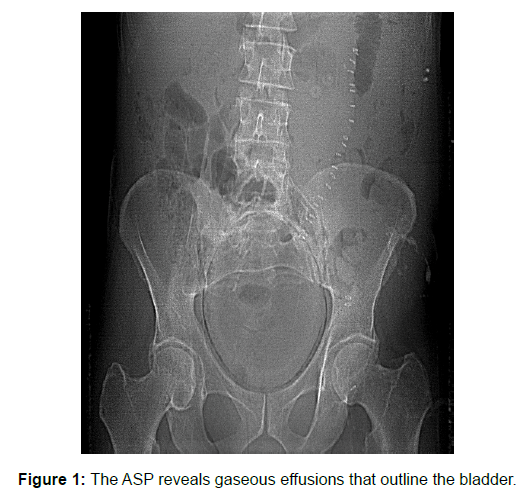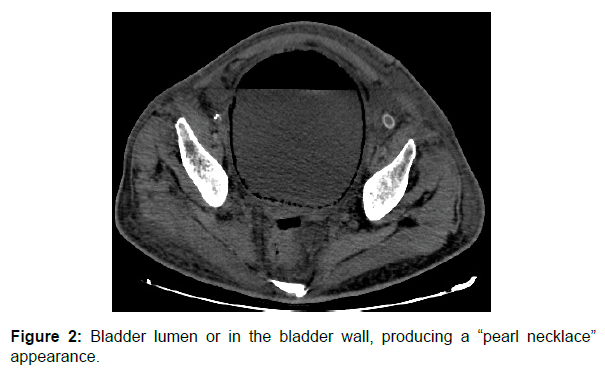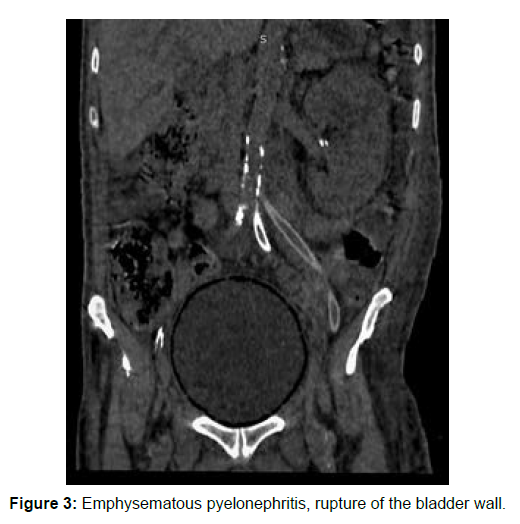Emphysematous Cystitis: The Pearl Necklace Appearance
Received: 12-Nov-2021 / Accepted Date: 19-Nov-2021 / Published Date: 26-Nov-2021 DOI: 10.4172/2167-7964.1000350
Keywords: Emphysematous; Cystis
Image article
Emphysematous cystitis is a rare form of lower urinary tract infection. It is characterised by the presence of air in the bladder wall and/or intraluminal. It appears to be more common in women and the main risk factors are: diabetes, urinary incontinence, immunosuppression and factors favouring urinary stasis (neurogenic bladder, sub-bladder obstruction). The clinical symptomatology, although noisy, such as hypogastria pain, bladder irritation, pyuria, haematuria and, more rarely, pneumaturia, remains unspecific. The main germs involved are: Escherichia Coli and Klebsiella Pneumonia. Enterobacteriaceae, anaerobes and, more rarely, emphysematous cystitis with Candida Albans have been reported. These germs cause anaerobic fermentation of glucose with production of CO2, which dissects the bladder wall.
Imaging is an essential modality for diagnosis. Bladder ultrasound is not very helpful due to the presence of air which generates a lot of artefact. The ASP reveals gaseous effusions that outline the bladder (Figure 1). Finally, the abdominal and pelvic CT scan is the reference examination. It supports the diagnosis of emphysematous cystitis by demonstrating gas in the bladder lumen or in the bladder wall, producing a “pearl necklace” appearance (Figure 2 and 3). In addition, it allows us to look for complications (emphysematous pyelonephritis, rupture of the bladder wall) and to rule out differential diagnoses (Pneumaturia secondary to a communication between the bladder and a hollow organ: vesico-digestive or vesico-vaginal fistula). The treatment of emphysematous cystitis is medical if there are no complications. It combines the insertion of a urinary catheter, appropriate antibiotic, restoration of blood sugar control and correction of any other risk factors.
Citation: WM. Traore, RTY. Tessi, B. Onka, L.Jroundi, Fz. Laamrani (2021) Emphysematous Cystitis: The Pearl Necklace Appearance. OMICS J Radiol 10: 350. DOI: 10.4172/2167-7964.1000350
Copyright: © 2021 WM. Traore, et al. This is an open-access article distributed under the terms of the Creative Commons Attribution License, which permits unrestricted use, distribution, and reproduction in any medium, provided the original author and source are credited.
Select your language of interest to view the total content in your interested language
Share This Article
Open Access Journals
Article Tools
Article Usage
- Total views: 3041
- [From(publication date): 0-2021 - Nov 25, 2025]
- Breakdown by view type
- HTML page views: 2356
- PDF downloads: 685



